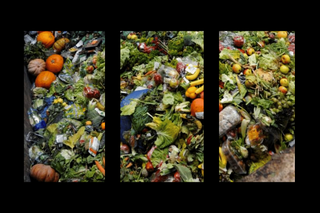
Almost 1 Billion Tons of Food Go To Waste Each Year, Finds UN Report
The report found low- and middle-income countries waste as much food as rich nations.

Almost one-fifth of food produced globally each year, about 17% of the total production, is wasted, according to a UN report published on March 4. This means 931 million metric tons of food go uneaten, a quantity that is equivalent to the combined weight of 23 million fully-loaded trucks.
The report, produced jointly by the United Nations Environment Programme (UNEP) and WRAP, a UK-based environmental NGO, is the most comprehensive work on food waste data collection and its analysis.
“If we want to get serious about tackling climate change, nature and biodiversity loss, and pollution and waste, businesses, governments, and citizens around the world have to do their part to reduce food waste,” said Inger Andersen, executive director of UNEP, in a press release.
Food waste is a pressing concern in today’s world because of the environmental toll the industry takes. Forests are cleared for crops, fuel is burned for farming and transportation, and packaging is produced to provide food. Wasted food ends up in landfills, releasing more greenhouse gases into the atmosphere. An estimated 8-10% of global greenhouse gas emissions are associated with food that is not consumed—an amount similar to the emissions road transportation releases.
The report found that contrary to popular belief that wealthier countries such as the U.K. and the U.S. produced more food waste, the amount of wasted food is more or less similar in both rich and poor countries. Almost two-thirds of this waste happens in households, while food services and retailers account for 26% and 13% respectively. “For a long time, it was assumed that food waste in the home was a significant problem only in developed countries,” said Marcus Gover, CEO of WRAP. “With the publication of the Food Waste Index report, we see that things are not so clear cut.”
Related on The Swaddle:
India’s Changing Food Habits Are Making It Impossible for It to Achieve Its Climate Goals
According to experts, food is sometimes wasted in poor countries because they don’t have reliable means for refrigeration or preservation of food. On the other hand, in richer countries, people tend to eat out more—contributing to retail food waste. Moreover, policies and cultural norms also contribute to waste at home: massive and unnecessary packaging, buy-one-get-one-free deals, improper disposal of food, lack of proper composting methods, and so on.
Food waste reduction offers multiple wins on multiple fronts for the planet: it improves food security, reduces pressure on land, water, and waste-management systems, and addresses climate change.
However, this potential has been largely overlooked as the true scale of food waste and its impact have not yet been clearly understood. “Many countries haven’t yet quantified their food waste, so they don’t understand the scale of the problem,” said Clementine O’Connor, a UNEP member and co-author of the report. The report also gives a methodology for countries to measure food waste in addition to calculating the global waste estimate.
Currently, there is insufficient data on the breakdown between the amount of edible and inedible food waste. It is only available in select high-income countries, and there remains a lack of information from lower-income countries. It is crucial to fill this knowledge gap, according to the report.
According to the authors of the report, food was generally more valued a few generations ago since people often couldn’t afford to waste it. Awareness about the scale of food waste globally could help shift attitudes back to that era, the report posits. Experts say that improved waste tracking and disposal is key to ease the problem, along with devising programs such as diverting inedible scraps of food to use as animal feed or fertilizer.
Against that backdrop and with Covid19 threatening to exacerbate poverty, hunger, and waste globally, the study urges consumers not to waste food at home. In 2019, about 690 million people were affected by hunger and three billion were unable to afford a healthy diet. Previous estimates of consumer food waste severely underestimated this scale — although it is hard to make direct comparisons because of the lack of data from many countries.
The U.N. is also pushing to reduce food waste globally. Sustainable Development Goals (SDG) are 17 interlinked global goals that the U.N. adopted in 2015 to achieve a better and more sustainable future for all. The target 12.3 of the SDG aims to halve per capita global food waste. The UNEP will launch groups to aid countries’ capacities to measure and record food waste, support countries as they develop national baselines to track progress towards the 2030 goal, and design strategies to prevent food waste.
“With only nine years to go, we will not achieve SDG 12 Target 3 if we do not significantly increase investment in tackling food waste in the home globally,” added Gover. “This must be a priority for governments, international organisations, businesses and philanthropic foundations.”
Satviki Sanjay is an editorial intern at The Swaddle. She's currently studying philosophy at Miranda House. When not studying, she can be found writing about gender, internet culture, sexuality, technology, and mental health. She loves talking to people, and you can always find her on Instagram @satvikii.
Related


Species Are Becoming More Homogenous, Signaling a New Kind of Biodiversity Crisis: Study
